MITSUBISHI OUTLANDER 2020 Owner's Manual (in English)
Manufacturer: MITSUBISHI, Model Year: 2020, Model line: OUTLANDER, Model: MITSUBISHI OUTLANDER 2020Pages: 443, PDF Size: 60.03 MB
Page 351 of 443
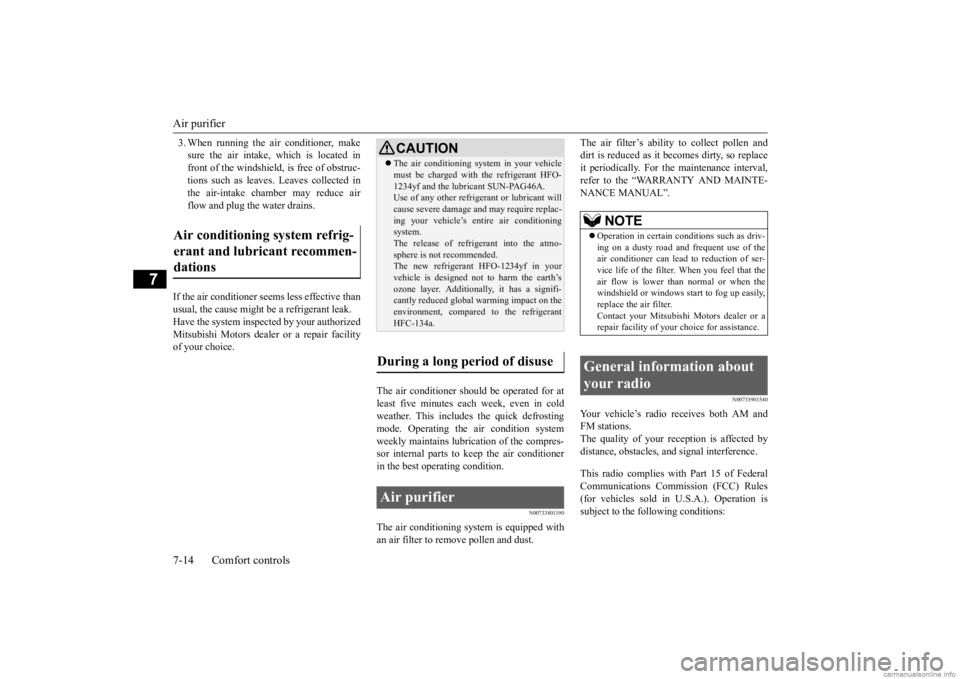
Air purifier 7-14 Comfort controls
7
3. When running the air conditioner, make sure the air intake, which is located infront of the windshield, is free of obstruc- tions such as leaves. Leaves collected in the air-intake chamber may reduce airflow and plug the water drains.
If the air conditioner seem
s less effective than
usual, the cause might
be a refrigerant leak.
Have the system inspected by your authorized Mitsubishi Motors dealer
or a repair facility
of your choice.
The air conditioner should be operated for at least five minutes each week, even in cold weather. This includes the quick defrostingmode. Operating the
air condition system
weekly maintains lubrication of the compres- sor internal parts to keep the air conditionerin the best operating condition.
N00733801190
The air conditioning syst
em is equipped with
an air filter to remove pollen and dust.
The air filter’s ability to collect pollen and dirt is reduced as it be
comes dirty, so replace
it periodically. For the maintenance interval, refer to the “WARRANTY AND MAINTE- NANCE MANUAL”.
N00733901540
Your vehicle’s radio receives both AM andFM stations.The quality of your re
ception is affected by
distance, obstacles, an
d signal interference.
This radio complies wi
th Part 15 of Federal
Communications Commission (FCC) Rules(for vehicles sold in U.S.A.). Operation is subject to the following conditions:
Air conditioning system refrig- erant and lubricant recommen- dations
CAUTION The air conditioning system in your vehicle must be charged with the refrigerant HFO-1234yf and the lubricant SUN-PAG46A.Use of any other refrigerant or lubricant will cause severe damage a
nd may require replac-
ing your vehicle’s en
tire air conditioning
system. The release of refrigerant into the atmo- sphere is not recommended.The new refrigerant HFO-1234yf in your vehicle is designed not
to harm the earth’s
ozone layer. Additionall
y, it has a signifi-
cantly reduced global
warming impact on the
environment, compared to the refrigerant HFC-134a.
During a long period of disuse Air purifier
NOTE
Operation in certain conditions such as driv- ing on a dusty road and frequent use of the air conditioner ca
n lead to reduction of ser-
vice life of the filter. When you feel that theair flow is lower than normal or when the windshield or windows st
art to fog up easily,
replace the air filter.Contact your Mitsubishi
Motors dealer or a
repair facility of your
choice for assistance.
General information about your radio
BK0278200US.book 14 ページ 2019年4月10日 水曜日 午前10時59分
Page 352 of 443
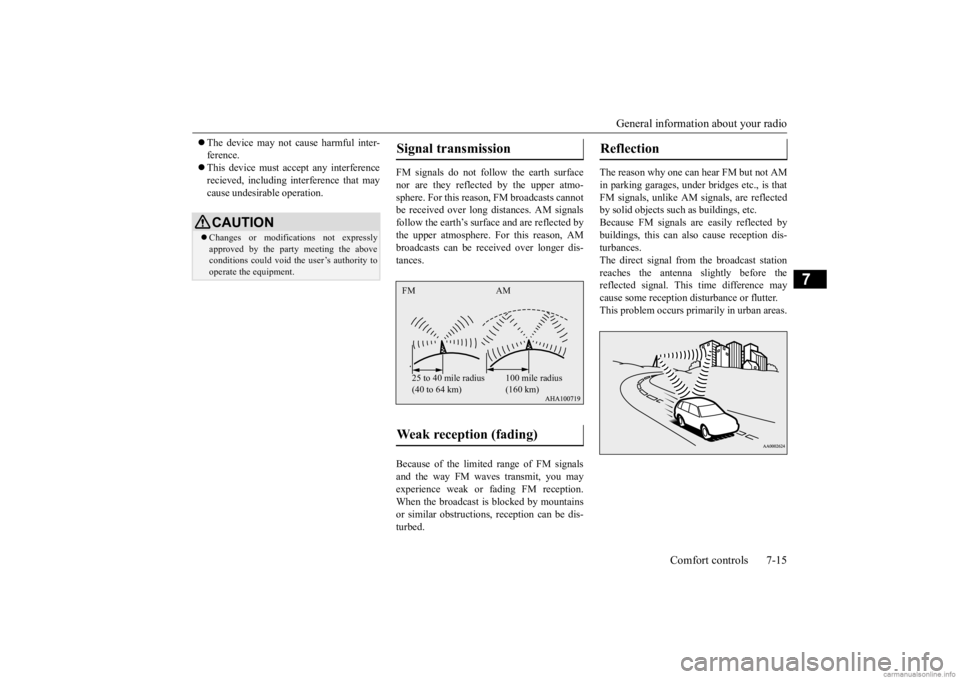
General information about your radio
Comfort controls 7-15
7
The device may not cause harmful inter- ference. This device must ac
cept any interference
recieved, including interference that may cause undesirable operation.
FM signals do not follow the earth surface nor are they reflected by the upper atmo- sphere. For this reason
, FM broadcasts cannot
be received over long
distances. AM signals
follow the earth’s surface and are reflected by the upper atmosphere. For this reason, AM broadcasts can be rece
ived over longer dis-
tances. Because of the limited range of FM signals and the way FM wave
s transmit, you may
experience weak or fading FM reception.When the broadcast is
blocked by mountains
or similar obstructions,
reception ca
n be dis-
turbed.
The reason why one can hear FM but not AM in parking garages, under
bridges etc., is that
FM signals, unlike AM
signals, are reflected
by solid objects such
as buildings, etc.
Because FM signals ar
e easily reflected by
buildings, this can also cause reception dis- turbances.The direct signal from
the broadcast station
reaches the antenna sl
ightly before the
reflected signal. This
time difference may
cause some reception di
sturbance or flutter.
This problem occurs primarily in urban areas.
CAUTION Changes or modifica
tions not expressly
approved by the party meeting the above conditions could void th
e user’s authority to
operate the equipment.
Signal transmission Weak reception (fading) FM AM 25 to 40 mile radius (40 to 64 km)
100 mile radius (160 km)
Reflection
BK0278200US.book 15 ページ 2019年4月10日 水曜日 午前10時59分
Page 353 of 443
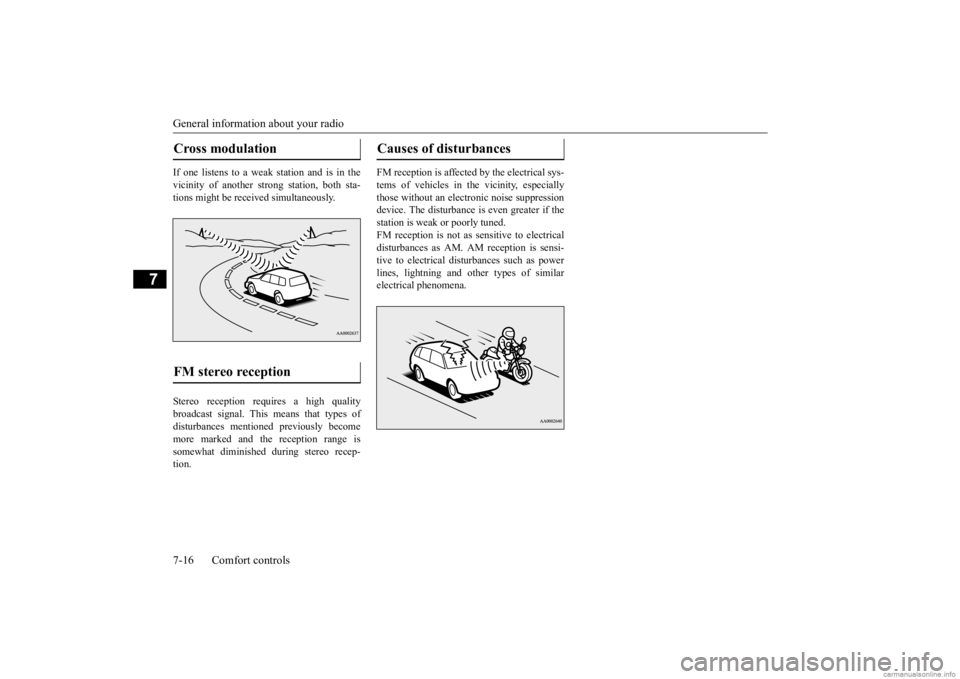
General information about your radio 7-16 Comfort controls
7
If one listens to a weak station and is in the vicinity of another st
rong station, both sta-
tions might be receiv
ed simultaneously.
Stereo reception requires a high quality broadcast signal. This
means that types of
disturbances mentione
d previously become
more marked and the reception range is somewhat diminished during stereo recep-tion.
FM reception is affected by the electrical sys- tems of vehicles in
the vicinity, especially
those without an elec
tronic noise suppression
device. The disturbance is even greater if thestation is weak or poorly tuned. FM reception is not as
sensitive to electrical
disturbances as AM. AM
reception is sensi-
tive to electrical dist
urbances such as power
lines, lightning and ot
her types of similar
electrical phenomena.
Cross modulation FM stereo reception
Causes of disturbances
BK0278200US.book 16 ページ 2019年4月10日 水曜日 午前10時59分
Page 354 of 443
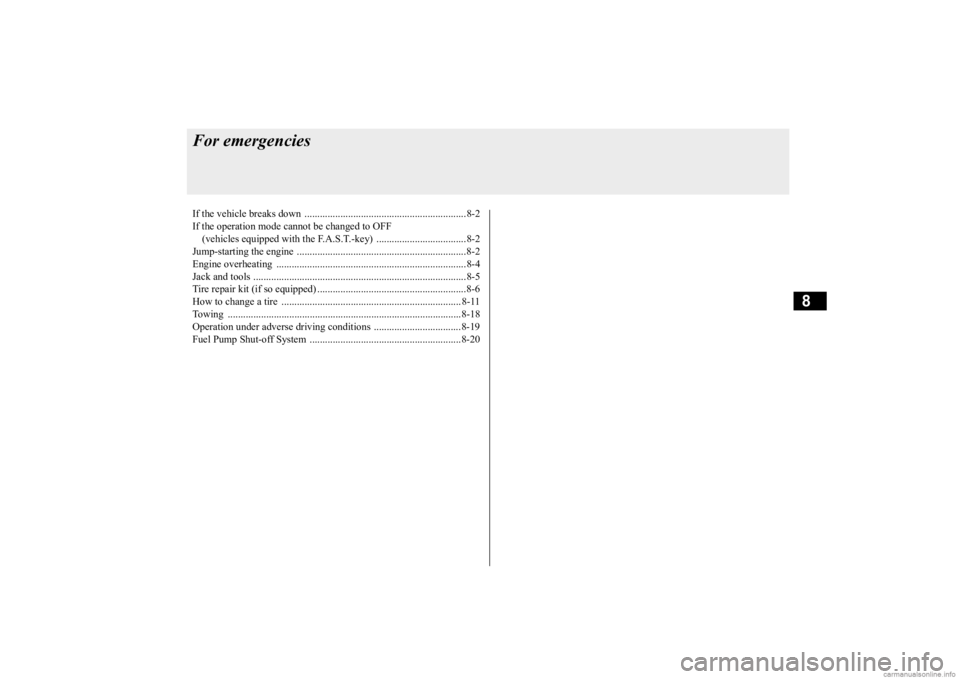
8
For emergenciesIf the vehicle breaks down ...............................................................8-2 If the operation mode ca
nnot be changed to OFF
(vehicles equipped with the F.A.S.T.-key) ...................................8-2Jump-starting the engine ..................................................................8-2 Engine overheating ..........................................................................8-4 Jack and tools ...................................................................................8-5Tire repair kit (if so equipped) ..........................................................8-6 How to change a tire ...................................................................... 8-11 Towing ...........................................................................................8-18Operation under adverse driving conditions
...........
.........
.........
.....8-19
Fuel Pump Shut-off System ...........................................................8-20
BK0278200US.book 1 ページ 2019年4月10日 水曜日 午前10時59分
Page 355 of 443
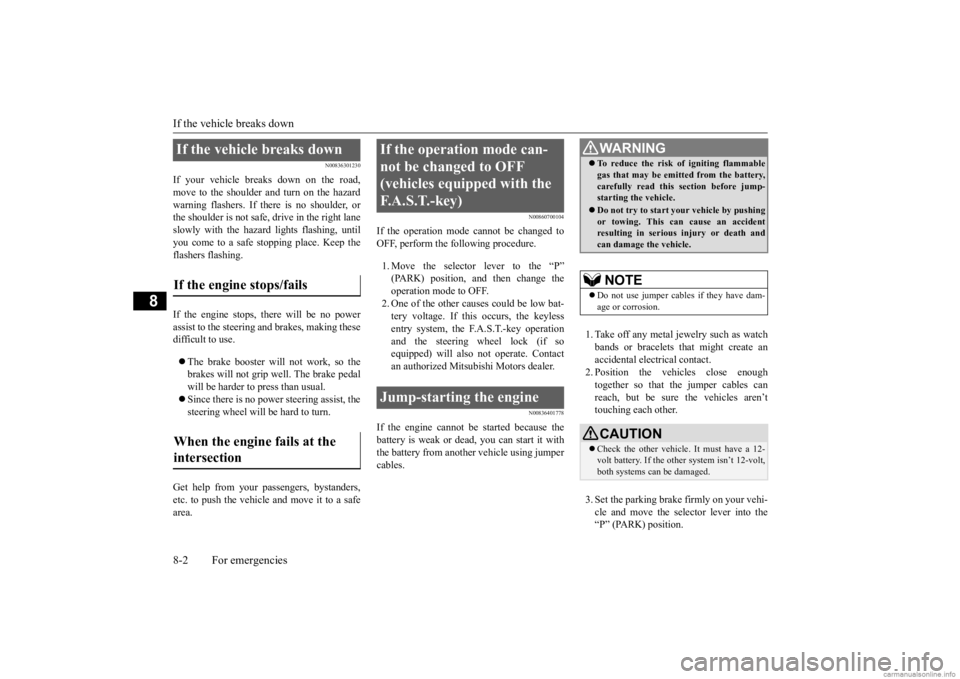
If the vehicle breaks down 8-2 For emergencies
8
N00836301230
If your vehicle breaks down on the road, move to the shoulder and turn on the hazard warning flashers. If there is no shoulder, orthe shoulder is not safe, drive in the right lane slowly with the hazard
lights flashing, until
you come to a safe stopping place. Keep theflashers flashing. If the engine stops, there will be no power assist to the steering and brakes, making these difficult to use. The brake booster will not work, so the brakes will not grip well. The brake pedal will be harder to press than usual. Since there is no power steering assist, the steering wheel will be hard to turn.
Get help from your passengers, bystanders, etc. to push the vehicle
and move it to a safe
area.
N00860700104
If the operation mode
cannot be changed to
OFF, perform the following procedure. 1. Move the selector lever to the “P” (PARK) position, and then change the operation mode to OFF. 2. One of the other causes could be low bat-tery voltage. If this occurs, the keyless entry system, the F.A.S.T.-key operation and the steering wheel lock (if soequipped) will also
not operate. Contact
an authorized Mitsubishi Motors dealer.
N00836401778
If the engine cannot be started because thebattery is weak or de
ad, you can start it with
the battery from anothe
r vehicle using jumper
cables.
1. Take off any metal jewelry such as watch bands or bracelets th
at might create an
accidental electrical contact. 2. Position the vehicles close enoughtogether so that the jumper cables can reach, but be sure the vehicles aren’t touching each other. 3. Set the parking brake firmly on your vehi- cle and move the selector lever into the“P” (PARK) position.
If the vehicle breaks down If the engine stops/fails When the engine fails at the intersection
If the operation mode can- not be changed to OFF (vehicles equipped with the F.A.S.T.-key) Jump-starting the engine
WA R N I N G To reduce the risk of igniting flammable gas that may be emi
tted from the battery,
carefully read this section before jump-starting the vehicle. Do not try to start you
r vehicle by pushing
or towing. This can cause an accident resulting in serious
injury or death and
can damage the vehicle.NOTE
Do not use jumper cables if they have dam- age or corrosion.CAUTION Check the other vehicle.
It must have a 12-
volt battery. If the other system isn’t 12-volt,both systems can be damaged.
BK0278200US.book 2 ページ 2019年4月10日 水曜日 午前10時59分
Page 356 of 443
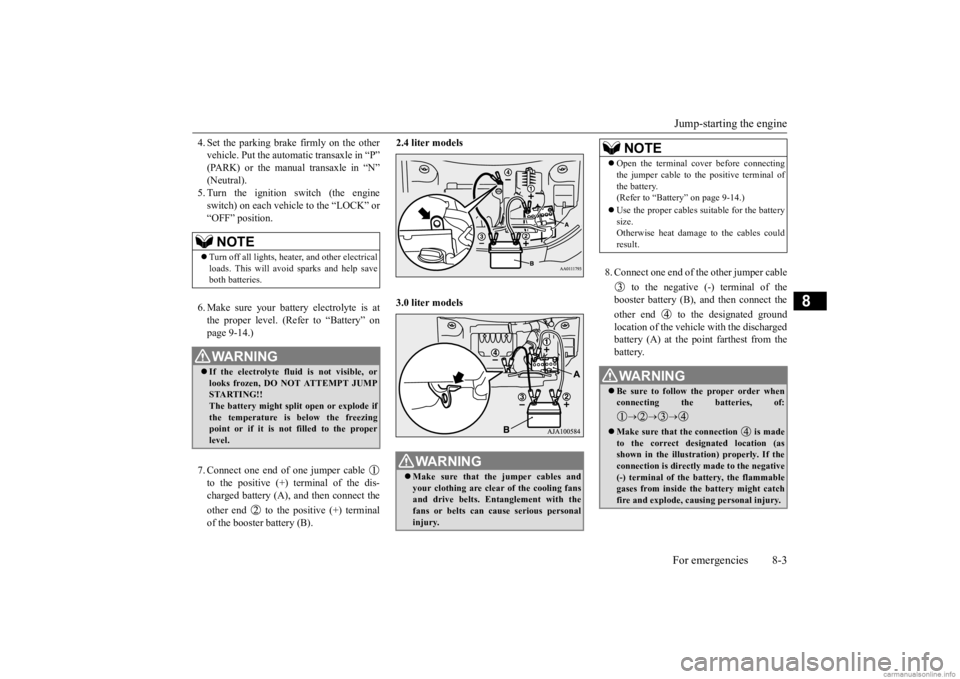
Jump-starting the engine For emergencies 8-3
8
4. Set the parking brake firmly on the other vehicle. Put the automatic transaxle in “P”(PARK) or the manual transaxle in “N” (Neutral). 5. Turn the ignition switch (the engineswitch) on each vehicle to the “LOCK” or “OFF” position. 6. Make sure your batt
ery electrolyte is at
the proper level. (Refer to “Battery” onpage 9-14.) 7. Connect one end of one jumper cable to the positive (+) terminal of the dis-charged battery (A),
and then connect the
other end to the positive (+) terminal of the booster battery (B).
2.4 liter models 3.0 liter models
8. Connect one end of the other jumper cable
to the negative (-) terminal of the booster battery (B), a
nd then connect the
other end to the designated ground location of the vehicl
e with the discharged
battery (A) at the point farthest from thebattery.
NOTE
Turn off all lights, heat
er, and other electrical
loads. This will avoid sparks and help saveboth batteries.WA R N I N G If the electrolyte flui
d is not visible, or
looks frozen, DO NOT ATTEMPT JUMP STARTING!!The battery might split open or explode if the temperature is below the freezing point or if it is not filled to the properlevel.
WA R N I N G Make sure that the jumper cables and your clothing are clear of the cooling fans and drive belts. Entanglement with the fans or belts can ca
use serious personal
injury.
NOTE
Open the terminal co
ver before connecting
the jumper cable to the positive terminal ofthe battery.(Refer to “Battery” on page 9-14.) Use the proper cables suitable for the battery size. Otherwise heat damage
to the cables could
result.WA R N I N G Be sure to follow the proper order when connecting the batteries, of:
Make sure that the connection is made to the correct designated location (as shown in the illustration) properly. If the connection is directly made to the negative(-) terminal of the battery, the flammable gases from inside the battery might catch fire and explode, caus
ing personal injury.
BK0278200US.book 3 ページ 2019年4月10日 水曜日 午前10時59分
Page 357 of 443
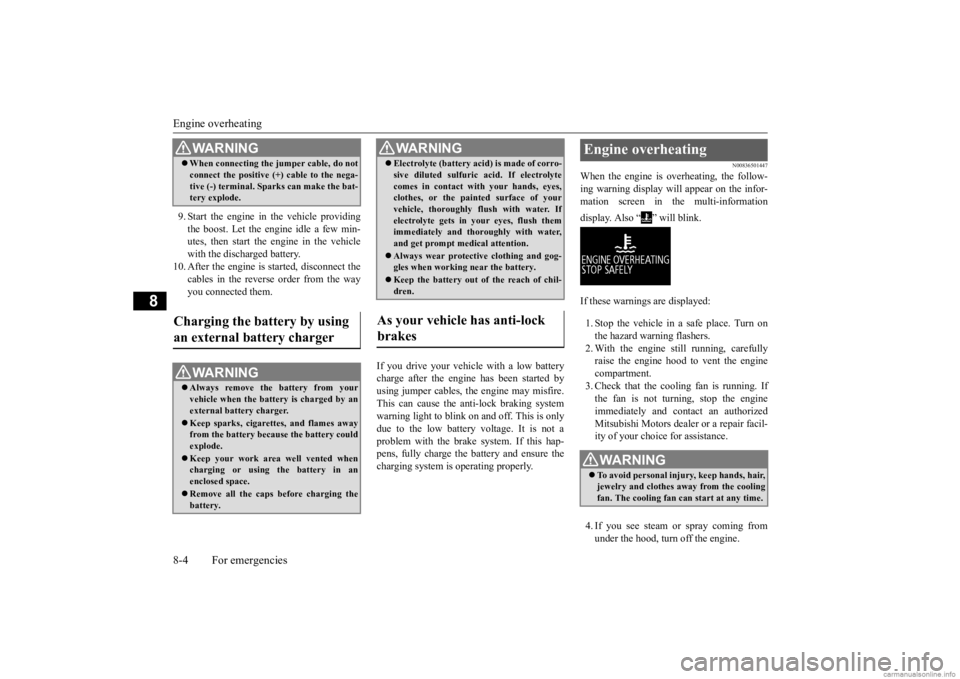
Engine overheating 8-4 For emergencies
8
9. Start the engine in the vehicle providing the boost. Let the engine idle a few min- utes, then start the engine in the vehiclewith the discharged battery.
10. After the engine is
started, disconnect the
cables in the reverse order from the wayyou connected them.
If you drive your vehicl
e with a low battery
charge after the engine has been started byusing jumper cables, th
e engine may misfire.
This can cause the anti-lock braking system warning light to blink on
and off. This is only
due to the low battery voltage. It is not a problem with the brake system. If this hap- pens, fully charge the battery and ensure thecharging system is operating properly.
N00836501447
When the engine is overheating, the follow- ing warning display will appear on the infor- mation screen in the multi-information display. Also “ ” will blink. If these warnings are displayed: 1. Stop the vehicle in a safe place. Turn on the hazard warning flashers. 2. With the engine st
ill running, carefully
raise the engine hood to vent the enginecompartment. 3. Check that the cooling fan is running. If the fan is not turn
ing, stop the engine
immediately and cont
act an authorized
Mitsubishi Motors dealer or a repair facil- ity of your choice for assistance. 4. If you see steam or spray coming from under the hood, turn off the engine.
When connecting the jumper cable, do not connect the positive (+) cable to the nega-tive (-) terminal. Sparks can make the bat-tery explode.
Charging the battery by using an external battery charger
WA R N I N G Always remove the
battery from your
vehicle when the battery is charged by an external battery charger. Keep sparks, cigarette
s, and flames away
from the battery because the battery could explode. Keep your work area well vented when charging or using
the battery in an
enclosed space. Remove all the caps before charging the battery.WA R N I N G
Electrolyte (battery acid) is made of corro- sive diluted sulfuric acid. If electrolytecomes in contact with your hands, eyes,clothes, or the pain
ted surface of your
vehicle, thoroughly flush with water. If electrolyte gets in your eyes, flush themimmediately and thoroughly with water, and get prompt medical attention. Always wear protecti
ve clothing and gog-
gles when working
near the battery.
Keep the battery out of
the reach of chil-
dren.
As your vehicle has anti-lock brakes
WA R N I N G
Engine overheating
WA R N I N G To avoid personal injury, keep hands, hair, jewelry and clothes aw
ay from the cooling
fan. The cooling fan ca
n start at any time.
BK0278200US.book 4 ページ 2019年4月10日 水曜日 午前10時59分
Page 358 of 443
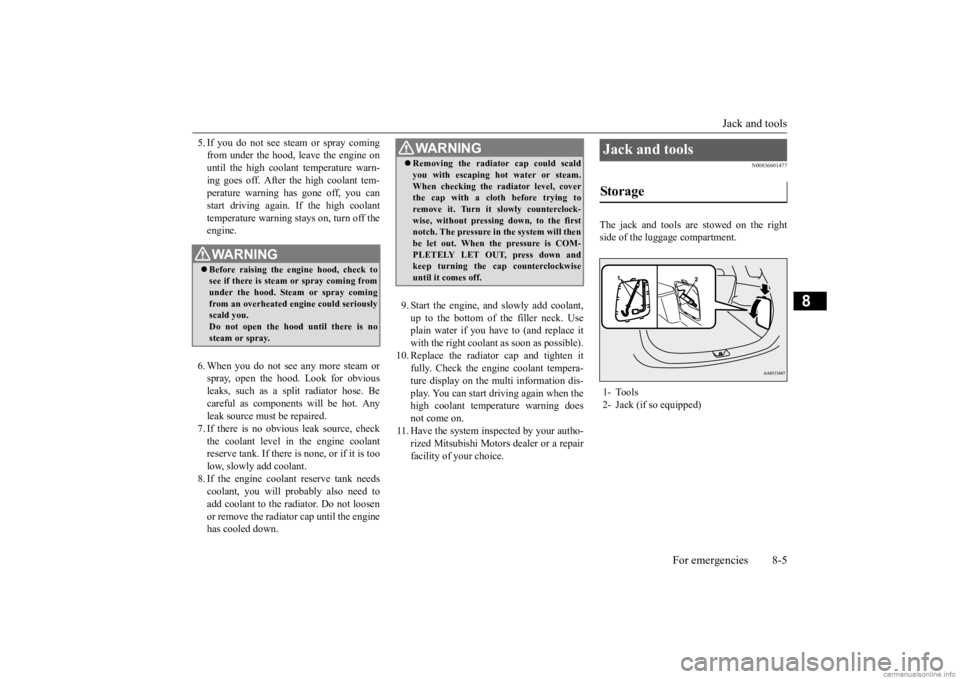
Jack and tools
For emergencies 8-5
8
5. If you do not see stea
m or spray coming
from under the hood, leave the engine onuntil the high coolant temperature warn- ing goes off. After the high coolant tem- perature warning has gone off, you canstart driving again. If the high coolant temperature warning stays on, turn off the engine. 6. When you do not see any more steam or spray, open the hood. Look for obviousleaks, such as a split radiator hose. Be careful as components will be hot. Any leak source must be repaired.7. If there is no obvious leak source, check the coolant level in the engine coolant reserve tank. If there is
none, or if it is too
low, slowly add coolant. 8. If the engine coolant reserve tank needs coolant, you will probably also need toadd coolant to the radiator. Do not loosen or remove the radiator cap until the engine has cooled down.
9. Start the engine, a
nd slowly add coolant,
up to the bottom of the filler neck. Use plain water if you have to (and replace itwith the right coolant as soon as possible).
10. Replace the radiator cap and tighten it
fully. Check the engine coolant tempera-ture display on the mu
lti information dis-
play. You can start driving again when the high coolant temperature warning doesnot come on.
11. Have the system inspected by your autho-
rized Mitsubishi Motors
dealer or a repair
facility of your choice.
N00836601477
The jack and tools are stowed on the rightside of the luggage compartment.
WA R N I N G Before raising the en
gine hood, check to
see if there is steam or spray coming from under the hood. Steam or spray comingfrom an overheated en
gine could seriously
scald you. Do not open the hood until there is nosteam or spray.
WA R N I N G Removing the radiat
or cap could scald
you with escaping hot water or steam.When checking the radiator level, coverthe cap with a cloth before trying to remove it. Turn it slowly counterclock- wise, without pressing down, to the firstnotch. The pressure in the system will then be let out. When the pressure is COM- PLETELY LET OUT, press down andkeep turning the cap counterclockwise until it comes off.
Jack and tools Storage 1- Tools 2- Jack (if so equipped)
BK0278200US.book 5 ページ 2019年4月10日 水曜日 午前10時59分
Page 359 of 443
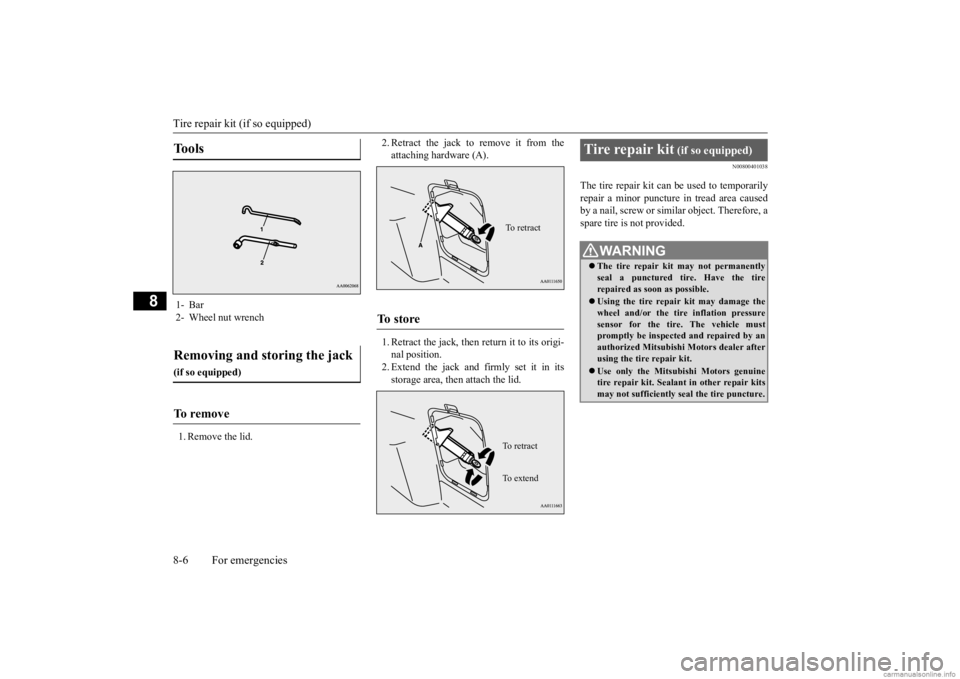
Tire repair kit (if so equipped) 8-6 For emergencies
8
1. Remove the lid.
2. Retract the jack to remove it from the attaching hardware (A). 1. Retract the jack, then return it to its origi- nal position. 2. Extend the jack and firmly set it in its storage area, then attach the lid.
N00800401038
The tire repair kit can be used to temporarilyrepair a minor puncture in tread area causedby a nail, screw or simi
lar object. Therefore, a
spare tire is not provided.
Tools 1- Bar2- Wheel nut wrenchRemoving and storing the jack
(if so equipped)To r e m o v e
To s t o r e
To retractTo r e t r a c t To e x t e n d
Tire repair kit
(if so equipped)
WA R N I N G The tire repair kit may not permanently seal a punctured tire. Have the tire repaired as soon as possible. Using the tire repair kit may damage the wheel and/or the tire
inflation pressure
sensor for the tire. The vehicle must promptly be inspected and repaired by an authorized Mitsubishi
Motors dealer after
using the tire repair kit. Use only the Mitsubishi Motors genuine tire repair kit. Sealant in other repair kits may not sufficiently seal the tire puncture.
BK0278200US.book 6 ページ 2019年4月10日 水曜日 午前10時59分
Page 360 of 443
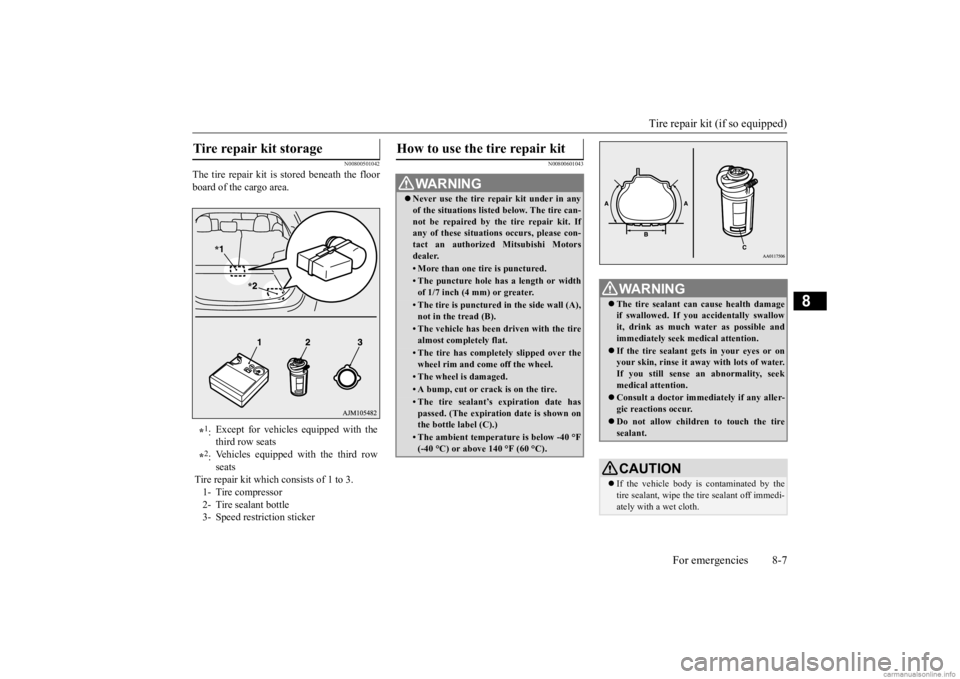
Tire repair kit (if so equipped)
For emergencies 8-7
8
N00800501042
The tire repair kit is stored beneath the floor board of the cargo area.
N00800601043
Tire repair kit storage
*1: Except for vehicles equipped with the third row seats
*2: Vehicles equipped with the third row seats
Tire repair kit which
consists of 1 to 3.
1- Tire compressor 2- Tire sealant bottle 3- Speed restriction sticker
How to use the tire repair kit
WA R N I N G Never use the tire repair kit under in any of the situations listed below. The tire can-not be repaired by the tire repair kit. If any of these situations occurs, please con- tact an authorized
Mitsubishi Motors
dealer.• More than one tire is punctured.• The puncture hole has a length or widthof 1/7 inch (4 mm) or greater.• The tire is punctured in the side wall (A),not in the tread (B).• The vehicle has been driven with the tirealmost completely flat.• The tire has completely slipped over thewheel rim and come off the wheel.• The wheel is damaged.• A bump, cut or crack is on the tire.• The tire sealant’s expiration date haspassed. (The expiration date is shown on the bottle label (C).)• The ambient temperature is below -40 °F(-40 °C) or above 140 °F (60 °C).
WA R N I N G The tire sealant can
cause health damage
if swallowed. If you
accidentally swallow
it, drink as much water as possible and immediately seek medical attention. If the tire sealant gets in your eyes or on your skin, rinse it away with lots of water. If you still sense an abnormality, seekmedical attention. Consult a doctor immediately if any aller- gic reactions occur. Do not allow children to touch the tire sealant.CAUTION If the vehicle body is contaminated by the tire sealant, wipe the tire sealant off immedi- ately with a wet cloth.
BK0278200US.book 7 ページ 2019年4月10日 水曜日 午前10時59分